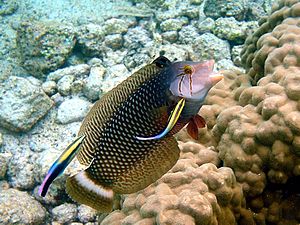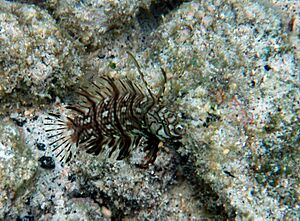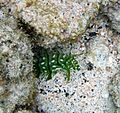Rockmover wrasse facts for kids
Quick facts for kids Rockmover wrasse |
|
|---|---|
 |
|
| With two cleaner wrasses | |
| Conservation status | |
| Scientific classification | |
| Synonyms | |
|
Genus:
Species:
|
The Novaculichthys taeniourus, also known as the rockmover wrasse, is a fascinating fish. People also call it the carpet wrasse, dragon wrasse, or reindeer wrasse. This type of wrasse lives mainly in coral reefs and lagoons. You can find them in the Indo-Pacific region. This includes places like the Gulf of California, Hawaii, the Philippines, Australia, and parts of the Indian Ocean.
The name "rockmover wrasse" comes from how they find food. They flip over small stones and pieces of reef. They do this to look for tasty snacks hiding underneath. This fish is the only known member of its group, or genus.
Contents
What's in a Name?
The scientific name Novaculichthys taeniourus has a special meaning. "Novaculichthys" comes from Latin and Greek words. Novacula means "razor" and ikhthús means "fish". So, it's like "razor fish."
The second part, "taeniourus", also comes from Greek. Tainía means "ribbon" and oura means "tail". This refers to its ribbon-like tail.
Appearance of the Rockmover Wrasse

The rockmover wrasse is a very colorful fish. It can grow to be about 27 to 30 centimeters long. That's about the length of a school ruler! Its body is shaped like an oval and is flat on the sides. Its head looks like a wedge.
Young rockmover wrasses look very different from adults. Young fish have two long spines on their back fin. These spines hang over their forehead, looking like a "cowlick" hairstyle. As the fish gets older, these long spines disappear.
Adult fish have a dark greenish-brown body. Each scale has a long white spot. Their head is gray-blue with brown lines around their eyes. They also have two black spots near their back fin. A wide white stripe is found at the base of their tail fin. The back part of their tail and their bottom fins are black. Young fish in Hawaii are often green, while those in the western Pacific are more burgundy or brownish. Both young fish types have white spots.
Because they look so different, young N. taeniourus are often called "dragon wrasses." The name "rockmover wrasse" is usually used for the adult fish.
Where They Live
Adult rockmover wrasses live in shallow reef areas. They can be found in lagoons and reefs facing the open ocean. They usually live in water from 14 to 25 meters deep. They like areas with a hard bottom, some grass, and a mix of sand and rocks. They also prefer places with a gentle ocean swell.
Young fish like shallow areas too. They often live among rubble near large coral patches. They can also be found in protected open spots on the top of reefs.
Reproduction
We don't know a lot about how these fish reproduce. However, like other wrasses, they probably can change their sex. They also likely release their eggs and sperm into the water. The eggs then float freely in the ocean.
Behavior
These fish are very protective of their space. Adult pairs often guard large areas of the reef.
Rockmover wrasses eat small creatures that live on the seafloor. These include snails, crabs, and worms. One fish will turn or move large pieces of rock or debris. It might grab or pull the rock with its mouth. Or it might push it with its snout. Once the food is uncovered, the other fish quickly grabs and eats it. Young fish usually work alone. They do all the rock-moving themselves. If they sense danger, these wrasses quickly dive into the sand to hide.
Young rockmover wrasses are very clever. They look like algae (seaweed). They even sway back and forth in the currents. This makes them look like floating seaweed. This helps them hide from predators.
Where They Are Found
Rockmover wrasses are found in many tropical areas. They live in reefs and lagoons across the Indian Ocean and Pacific Ocean.
Images for kids
-
Juvenile in Kona
See also
 In Spanish: Novaculichthys para niños
In Spanish: Novaculichthys para niños



